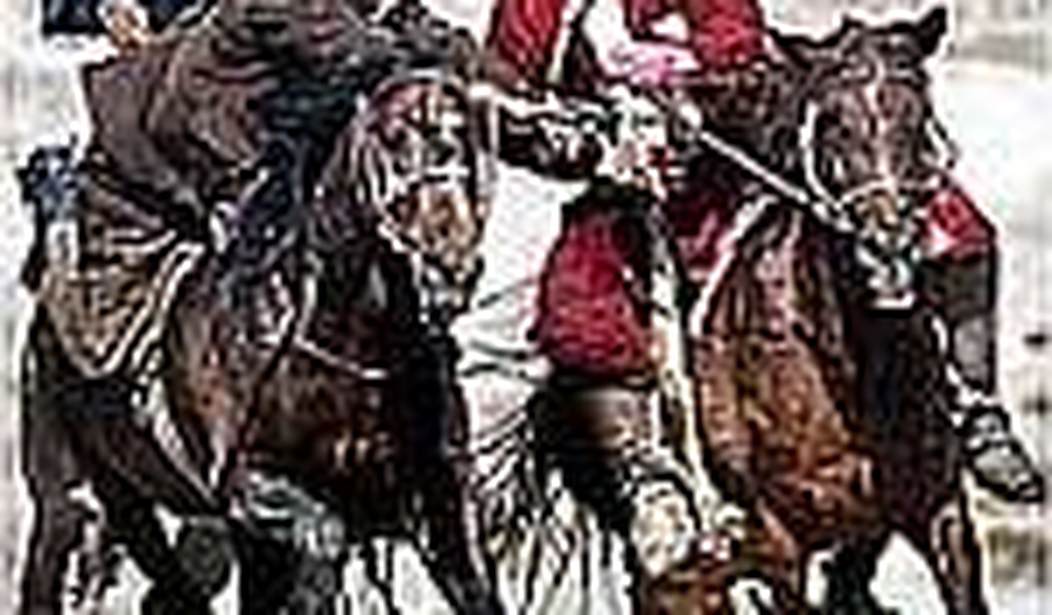The dozens of horses milling about in the middle of the field kick up a tremendous cloud of dust, obscuring much of the by-play between riders that is going on.
As they slash away viciously with whips while using their mounts to jostle other players (chopendoz), a glimpse can be had of the rider carrying the boz – the headless carcass of a dead goat. It has been soaked in water for 24 hours to toughen up the hide so that it can withstand the tremendous pounding it will take during the course of the game.
Suddenly, with a quick maneuver, one rider emerges from the crush and begins to gallop madly toward the other end of the field – about a mile away. From the escarpment above, the hoarse shouts of approval from hundreds of tribesmen lining the field for miles indicate the same kind of admiration an American crowd might give to a running back who had just faked a linebacker out of his jock with a great juke move.
The rider isn’t alone for long. After a couple hundred meters another large group of chopendoz have taken the perfect angle and are ready to cut him off. But the rider with the boz is not only an experienced player but an incredible horseman as well. Leaning far to the left until he is almost perpendicular to his saddle, barely hanging on to the 80-pound carcass, his well-trained mount makes an incredibly sharp turn to the left, leaving the other riders in his dust.
But his turn is taking him away from his goal — the hallal, or “circle of justice,” what we would call “paydirt.” It is the scoring zone for Buzkashi, the Afghani national game. The simple object of this game with few-to-no rules is to dump the carcass into the hallal and raise your arms in the universal signal of triumph. The first player to do so wins the contest and receives not only expensive gifts of weapons and clothes, but also the respect and admiration of his tribe.
There are several different kinds of Buzkashi. The current government has tried to standardize the game by allowing only 10 riders per side, and by moving the game into a stadium.
Some of the more brutal practices have been outlawed. For instance, players are not allowed to carry knives. And whipping an opponent is a no-no, although you can still whip the opponent’s horse. Accidents do happen, and in the process of flailing away at your opponent’s steed, if your whip happens to strike your opposite number – well, that’s just the “rub-o-the-green” as the Scots say.
This is the relatively civilized version game as it is played in the major cities. But up north where the game’s roots are deep and Buzkashi is as much a part of tribal life as hunting or going to war, a different sort of contest is played out. It is in the northern provinces of Afghanistan that the game becomes a struggle for survival where the skills of the warrior are utilized to their fullest.
Sometimes the game is played with two teams, or sides. Other times the game is a free-for-all with every man for himself. Some versions of the game feature a pole set miles from paydirt. The game begins as the carcass is placed in the hallal, and a huge melee ensues. In order to score, the rider must make a full circuit around the pole and back to the hallal. Other forms of the game are less organized, and can go on for days.
It’s an easy game to watch because there are no rules to worry about. The DVD I saw lasted about an hour, and was fairly good quality. Much of the game is the riders milling around in a swarm, trying to separate the carcass from the rider by any means necessary. It cries out for the Fox Broadcasting treatment. Cameras on the horses. Cameras in the riders’ traditional fur hats (fox fur designating a champion chopendoz). Cameras at the hillal to catch the moment of victory. Shot with one camera, only glimpses of the struggle can be seen through the dust cloud kicked up by the horses.
These horses are not the gentle beasts you would find on a dude ranch. These are extraordinary steeds, worthy descendants of the mounts used by the armies of Ghengis Khan. While not large, they are swift, and blessed with great endurance. It takes 5 years to train a horse to carry a Buzkashi rider. During that time, the horse is taught patience, and to stand and wait if the rider is unhorsed. A well trained Buzkashi horse can anticipate the rider’s wishes, and once the boz is in the saddle they kick it up a notch and run like quicksilver.
The game of Buzkashi traces its roots back to the 12th century, when the Mongols laid waste to wide swaths of Central Asia. The game may have started as a variation on tribal raids that targeted enemy livestock. It takes great skill as a horseman to lean out and scoop up such a prize. Those who could do it saw their status in the tribe rise. It’s not a big leap from warfare to competitive game, judging by what happens during the course of a no-holds-barred Buzkashi contest.
Death is common. Broken bones are part of the game. The whip used by the chopendoz leaves a painful cut wherever it lands. And while it is considered bad form to whip the hands of the player carrying the boz, the face is fair game. It is not unusual to see many faces covered in blood by the end of the contest.
It is not unheard of for one player to knife another’s horse – or even stab the boz carrier. But the chopendoz wear a heavily padded jacket over a chapan (a long coat) to gain some protection against such a thrust, as well as cushion the frequent falls that occur during a match.
There is strategy and nuance to the game – to a certain extent. Even in a game that’s every man for himself, temporary alliances are formed to prevent one player or another from winning. But those alliances can crumble in a flash, the former allies turning on each other viciously. In a team game that has no recognizable positions like “outside boz wrestler” or “interior horse disrupter,” there appear to be some players more adept at reaching down to retrieve the carcass, and others who are particularly well suited to chasing down the boz carrier. The latter players bide their time on the outside of the scrum until a breakout occurs. Then they take the perfect line to intercept the galloping rider, swooping in to make a play for the boz. Since the carcass is not tied to the saddle or the chopendoz, it becomes a real chore for the rider to hang on to the 80 pound boz for very long. The carcass can change hands dozens of times before a victory is achieved.
Watching these players race around the field, a look of concentration and determination on their faces, I was struck by the fact that we see that look all the time in our athletes. We like to say that a Michael Jordan or a Ty Cobb were fierce competitors in their day, that they would do anything to win. But they’re not really fierce in any real sense. Fierce is riding a Buzkashi horse over a dusty plain with a dozen riders behind you — another dozen bearing down on your flank — all bound and determined to use whatever means at their disposal to separate you from the carcass of a dead goat.
Now that’s fierce.
There is such a thing as the universality of sport. At the very end of this video clip, you will see the faces of the players following the game. You can tell immediately which team won and which team lost. And you can tell that no matter the outcome, the players are united as teammates, having shared the trials and dangers inherent in their sport.
It’s the same look you see on sidelines and dugouts all over this country following a game. Team sports are a shared experience. And the bonds between teammates are unlike any other connections one is likely to have. Those Afghan tribesmen may not know what basketball and football are. But they experience the same joys and sorrows of athletes the world over. In that, they are as modern as any people on earth.










Join the conversation as a VIP Member